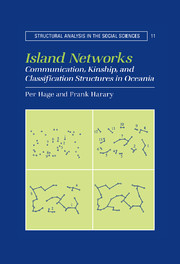6 - Centrality
Published online by Cambridge University Press: 06 August 2010
Summary
Mon centre cède, ma droite recule, situation excellente. J'attaque.
Marshall Ferdinand Foch, “Message to Joffre”One island may enjoy a structural advantage over other islands in a network by virtue of its more central location. Several Oceanists have relied on the concept of median centrality (“short-path connectivity”) in their analyses of trade networks (Brookfield and Hart 1971; Irwin 1974; Hunt 1988; Kirch 1988b). However, there are many different, empirically applicable ways of defining centrality in a graph (Buckley and Harary 1990).
In the following presentation we use the concepts of degree centrality, median centrality, and betweenness centrality to account for the emergence of trade and political centers in the Lau Islands, Fiji. Our analysis complements Thompson's (1949) ecological model of trade in southern Lau, offers a network alternative to Sahlins's (1962) theory of relative agricultural fertility as the primary determinant of trade centers in Fiji, and develops Reid's (1977) network explanation for the rise of Lakemba as a political power in eastern Fiji. We use the prototypic graph theoretic definition of centrality, which is based on the eccentricity rather than the distance sum of a node, to account for the location of political capitals and mythological centers in the Ralik and Ratak chains of the Marshall Islands. We introduce the concept of betweenness in a rooted graph to evaluate Harris's (1979) hypothesis concerning the relation between trade and subsistence practices in the western islands of Torres Strait.
Information
- Type
- Chapter
- Information
- Island NetworksCommunication, Kinship, and Classification Structures in Oceania, pp. 165 - 203Publisher: Cambridge University PressPrint publication year: 1996
Accessibility standard: Unknown
- 1
- Cited by
